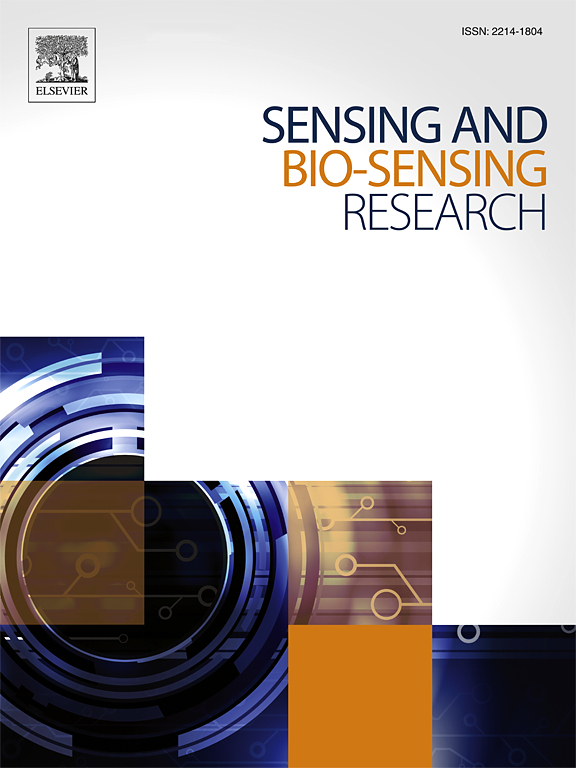A novel smartphone-based nanozyme-enhanced electrochemical immunosensor for ultrasensitive direct detection of Staphylococcus aureus in milk and blood serum
IF 4.9
Q1 CHEMISTRY, ANALYTICAL
引用次数: 0
Abstract
A graphene quantum dot (GQD)-based nanozyme-enhanced electrochemical sensor was developed for the ultra-sensitive and rapid Staphylococcus aureus detection in PBS, undiluted milk, and blood serum. The S. aureus concentration for immunosensor calibration was electrochemically determined to be 1.24× 109 CFU mL−1 (R2 = 0.99), utilizing an innovative smartphone-based electrochemical device. Transmission electron (TEM) and atomic force (AFM) microscopy analyses of GQDs revealed uniform nanoparticles (8–10 nm) with surface heights of 2 nm and 21 nm at different scan areas. Fluorescence and Fourier transform infrared spectroscopy spectra showed an emission at 530 nm with an excitation wavelength of 485 nm, along with the presence of hydroxyl, carboxyl, and aromatic groups on the GQD surfaces. The maximum current peak for GQDs was obtained by optimizing electrochemical properties through amperometry at +0.9 V. The optimal signal intensity- and limit of detection (LOD)-based GQD concentrations were 0.0125, 0.5, and 1 mg mL−1 for PBS, undiluted milk, and blood serum, respectively. The optimal antibody concentration for S. aureus detection was 25 μg mL−1, resulting in a 91 % amperometric suppression and a 94 % fluorescence quenching. The developed biosensor effectively detected S. aureus, with calculated LODs of 1, 4, and 344 CFU mL−1 in PBS, undiluted milk, and blood serum, respectively. TEM, AFM, and contact angle analyses confirmed S. aureus binding to the GQD-antibody bioconjugate, shifting surface height to 35 nm and contact angle from ~30° to ~65°. The immunosensor showed high specificity for S. aureus with minimal cross-reactivity to Listeria monocytogenes, Staphylococcus epidermidis, Enterococcus faecium, and Streptococcus pneumoniae.
一种基于智能手机的纳米酶增强电化学免疫传感器,用于超灵敏直接检测牛奶和血清中的金黄色葡萄球菌
研究了一种基于石墨烯量子点(GQD)的纳米酶增强电化学传感器,用于PBS、未稀释牛奶和血清中金黄色葡萄球菌的超灵敏快速检测。利用创新的基于智能手机的电化学装置,电化学测定用于免疫传感器校准的金黄色葡萄球菌浓度为1.24× 109 CFU mL−1 (R2 = 0.99)。透射电子显微镜(TEM)和原子力显微镜(AFM)分析表明,在不同的扫描区域,GQDs的表面高度分别为2 nm和21 nm,均匀分布在8 ~ 10 nm之间。荧光光谱和傅里叶变换红外光谱显示,GQD在530nm处发射,激发波长为485 nm,并且在GQD表面存在羟基、羧基和芳香基团。在+0.9 V时,通过安培法优化电化学性能,获得了GQDs的最大电流峰。PBS、未稀释牛奶和血清的最佳信号强度和检测限(LOD)分别为0.0125、0.5和1 mg mL - 1。检测金黄色葡萄球菌的最佳抗体浓度为25 μg mL−1,安培抑制率为91%,荧光猝灭率为94%。该传感器在PBS、未稀释牛奶和血清中有效检测金黄色葡萄球菌,lod分别为1、4和344 CFU mL−1。透射电镜(TEM)、原子力显微镜(AFM)和接触角分析证实,金黄色葡萄球菌与gqd抗体生物偶联物结合,将表面高度移至35 nm,接触角从~30°移至~65°。该免疫传感器对金黄色葡萄球菌具有高特异性,对单核细胞增生李斯特菌、表皮葡萄球菌、屎肠球菌和肺炎链球菌的交叉反应性极小。
本文章由计算机程序翻译,如有差异,请以英文原文为准。
求助全文
约1分钟内获得全文
求助全文
来源期刊

Sensing and Bio-Sensing Research
Engineering-Electrical and Electronic Engineering
CiteScore
10.70
自引率
3.80%
发文量
68
审稿时长
87 days
期刊介绍:
Sensing and Bio-Sensing Research is an open access journal dedicated to the research, design, development, and application of bio-sensing and sensing technologies. The editors will accept research papers, reviews, field trials, and validation studies that are of significant relevance. These submissions should describe new concepts, enhance understanding of the field, or offer insights into the practical application, manufacturing, and commercialization of bio-sensing and sensing technologies.
The journal covers a wide range of topics, including sensing principles and mechanisms, new materials development for transducers and recognition components, fabrication technology, and various types of sensors such as optical, electrochemical, mass-sensitive, gas, biosensors, and more. It also includes environmental, process control, and biomedical applications, signal processing, chemometrics, optoelectronic, mechanical, thermal, and magnetic sensors, as well as interface electronics. Additionally, it covers sensor systems and applications, µTAS (Micro Total Analysis Systems), development of solid-state devices for transducing physical signals, and analytical devices incorporating biological materials.
 求助内容:
求助内容: 应助结果提醒方式:
应助结果提醒方式:


